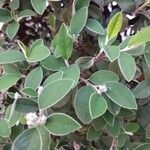Shrubs semievergreen, to 2 m tall. Branchlets dark grayish brown or purplish brown, thin, initially densely white tomentose, glabrescent. Petiole 2–7 mm, tomentose; stipules caducous, linear, pubescent; leaf blade narrowly elliptic, elliptic, or ovate, 2–3(–4) × 0.8–1.5 cm, leathery, midvein impressed adaxially, lateral veins 4–6 pairs, abaxially densely white tomentose, adaxially slightly pubescent or glabrous, base broadly cuneate, apex obtuse or acute. Corymbs 1–3 × 1.5–2.5 cm, to 10(–20)-flowered; rachis and pedicels densely tomentose; bracts caducous, linear, pubescent. Pedicel 2–3 mm. Flowers 7–8 mm in diam. Hypanthium campanulate, abaxially densely tomentose. Sepals triangular, apex shortly acuminate or acute. Petals spreading, white, broadly ovate or suborbicular, 3–3.5 mm, base shortly clawed and puberulous adaxially, apex obtuse. Stamens 20, nearly as long as petals; anthers purplish red. Ovary pubescent apically; styles 2(or 3), free, ca. as long as stamens. Fruit dark red, globose or ovoid, 7–8 mm in diam., pyrenes often 2. Fl. Jun, fr. Oct–Nov. 2n = 34*, 68*.
Perennial shrub, 2-5 m high; branches arched; branchlets thin, dark brown; initially covered with short, dense hairs shedding at maturity. Leaves simple, blades elliptic, 15-30 x 8-16 mm, apex mucronulate, glabrous above, whitish tomentose beneath; petioles 5-8 mm long. Flowers terminal corymbs, 8 mm in diam.; petals white, broadly ovate or subglobose, 3.0-3.5 mm long, base short, claw-bearing, apex obtuse; calyx bell-shaped and triangular, sepals apically short-acuminate or acute; petals and sepals glabrous inside and densely hairy outside. Bracts linear and caducous. Flowering time June, July. Fruit subglobose to ellipsoid. Seeds 2-5, 4-5 mm long.
Semi-evergreen shrub, up to 3 m high. Branches spreading, drooping at ends; unarmed. Leaves simple; blade ovate to elliptic, 10-25 x 5-15 mm, apex acute, margins entire, upper surface dull green and glabrous, lower surface densely whitish hairy; petioles 2-7 mm long. Flowers: corolla ± 10 mm in diameter; petals white; Oct., Nov. Fruit dull deep red, subglobose pomes with two nutlets.
Semi-evergreen shrub, up to 3 m high. Branches spreading, drooping at the ends. Leaves ovate to elliptic, dull / green, white-tomentose beneath. Fruits red, subglobose. Flowers white.









